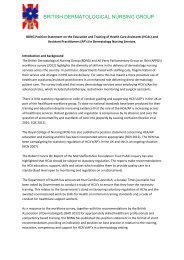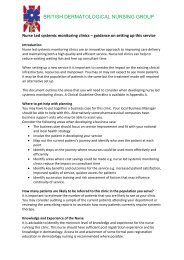Improving outcomes for people with skin tumours including melanoma
Improving outcomes for people with skin tumours including melanoma
Improving outcomes for people with skin tumours including melanoma
Create successful ePaper yourself
Turn your PDF publications into a flip-book with our unique Google optimized e-Paper software.
<strong>Improving</strong> Outcomes <strong>for</strong><br />
People <strong>with</strong> Skin Tumours<br />
<strong>including</strong> Melanoma<br />
Patient-centred care<br />
A. Recommendations<br />
Putting patient and carer needs at the centre of service<br />
design<br />
Cancer networks, through their site-specific groups and lead<br />
commissioners, should describe the demographic profile of the <strong>skin</strong><br />
cancer patients in their area in order to ensure that their needs are<br />
adequately met. In particular they should consider the impact of<br />
affluence and poverty on stage at presentation and ensure access to<br />
the entire range of services from prevention through to palliation.<br />
2<br />
Commissioners should develop an understanding of the spectrum of<br />
needs of service users through consultation arrangements and ensure<br />
that individuals from the local community have the facility and the<br />
confidence to raise and express concerns.<br />
Commissioners, together <strong>with</strong> their cancer network site-specific<br />
groups, should take into consideration the diversity of patients’ needs<br />
when configuring services and developing network protocols.<br />
Communication, in<strong>for</strong>mation provision and support<br />
Those who are directly involved in treating patients should receive<br />
specific training in communication and breaking bad news. They have<br />
a responsibility <strong>for</strong> good communication <strong>with</strong> patients and carers,<br />
<strong>including</strong> discussion of the risks and benefits in deciding about<br />
treatment options and involving patients as partners in care and<br />
treatment.<br />
Each LSMDT and SSMDT should have at least one <strong>skin</strong> cancer clinical<br />
nurse specialist (CNS) who will play a leading role in supporting<br />
patients and carers. There should be equity of access to in<strong>for</strong>mation<br />
and support regardless of where the care is delivered.<br />
All LSMDTs and SSMDTs should have access to psychological support<br />
services <strong>for</strong> <strong>skin</strong> cancer patients.<br />
Patients should be invited to bring a companion <strong>with</strong> them to<br />
consultations.<br />
34<br />
National Institute <strong>for</strong> Health and Clinical Excellence















